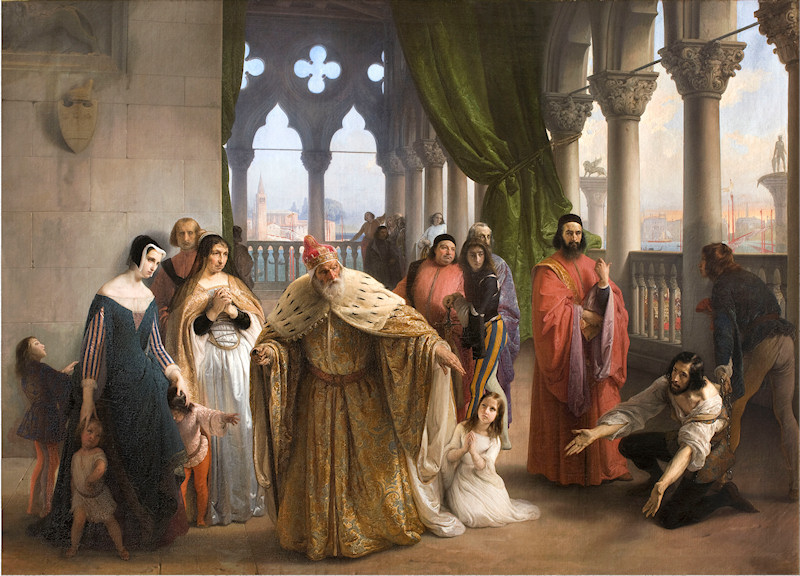Fil:Artgate Fondazione Cariplo - Hayez Francesco, L'ultimo abboccamento di Giacomo Foscari figlio del doge Giuseppe.jpg
Artgate_Fondazione_Cariplo_-_Hayez_Francesco,_L'ultimo_abboccamento_di_Giacomo_Foscari_figlio_del_doge_Giuseppe.jpg (800 × 576 pixlar, filstorlek: 176 kbyte, MIME-typ: image/jpeg)
| Denna fil tillhandahålls av Wikimedia Commons. Informationen nedan är kopierad från dess filbeskrivningssida. |
Sammanfattning
| Francesco Hayez: The Last Meeting between Jacopo Foscari and his Family Before Being Sent into Exile
|
||||||||||||||||||||||||||||
|---|---|---|---|---|---|---|---|---|---|---|---|---|---|---|---|---|---|---|---|---|---|---|---|---|---|---|---|---|
| Konstnär/skapare |
artist QS:P170,Q223725 |
|||||||||||||||||||||||||||
| Titel |
The Last Meeting between Jacopo Foscari and his Family Before Being Sent into Exile label QS:Lit,"L'ultimo abboccamento di Jacopo Foscari con la propria famiglia (I due Foscari)"
label QS:Len,"The Last Meeting between Jacopo Foscari and his Family Before Being Sent into Exile"
label QS:Lde,"Das letzte Zusammentreffen zwischen Jacopo Foscari und seiner Familie vor der Vertreibung ins Exil" |
|||||||||||||||||||||||||||
| Objekttyp |
målning object_type QS:P31,Q3305213 |
|||||||||||||||||||||||||||
| Beskrivning |
The painting was commissioned in 1838 by Emperor Ferdinand I, who had arrived in Milan for his coronation as king of Lombardy and Veneto, and it was destined for the Belvedere Gallery in Vienna. On its completion in 1840 the work was valued at the extremely high price of five thousand florins by the Commissione Permanente di Pittura dell’Accademia di Brera, which thus recognized its exceptional quality. In 1928 this large canvas was auctioned at the Galleria Scopinich in Milan, together with other valuable Italian paintings from the imperial collections, where it was bought by Antonio Bernocchi an important member of the rising entrepreneurial middle class, who was active in the textile sector and became senator of the Kingdom of Italy in 1929. The painting entered the Cariplo Collection from this prestigious private collection in 1989. Histoire de la République de Venise by the French historian Pierre Daru is the literary source of this episode regarding the Doge, who was forced to accept that his son Jacopo was sentenced to exile after being unjustly accused of treason. This subject had also been formerly addressed by Lord Byron in 1821 in his tragedy The Two Foscaris, which inspired the opera of the same name in 1844 by Giuseppe Verdi. The critics immediately recognised the theatrical appeal of history painting that often chose the same subjects as the more popular operas. The general public readily identified with the events depicted on canvas because of the precise reconstruction of settings, costumes and gestures, but also because they included portraits of their contemporaries as historical figures. In this canvas in the Collection the Doge is an older self portrait of Hayez himself, and with a dramatic gesture he forces his son to respect the decision of the Council of Ten, as he leans on his stick trembling with emotion. The differing reactions of the figures around him are evident: the silent suffering of the women; the icy expression of Jacopo’s enemy Loredano standing beside him, as the condemned son stretches out his hands towards his father; the various emotions of the children. Jacopo’s leavetaking of his family is rendered even more agonising by the allusion to his imminent departure from his homeland evident in the view of the lagoon with the ships about to set sail, which can be glimpsed through the portico of the Ducal Palace. The myth of Venice and the loneliness of the powerful are condensed in this episode, which Hayez treated repeatedly in several versions, including the famous canvas commissioned by his friend and adviser Andrea Maffei and executed between 1852 and 1854 (Florence, Galleria d’Arte Moderna Palazzo Pitti). The artist’s dramatic sensibility and the similarity between his painting and Verdi’s opera, was further confirmed when he was asked to revise the costume-sketches for the staging of The Two Foscaris in 1858. |
|||||||||||||||||||||||||||
| Avbildade personer |
Jacopo Foscari |
|||||||||||||||||||||||||||
| Datum |
mellan 1838 och 1840 date QS:P571,+1850-00-00T00:00:00Z/7,P1319,+1838-00-00T00:00:00Z/9,P1326,+1840-00-00T00:00:00Z/9 |
|||||||||||||||||||||||||||
| Teknik/material |
olja på duk medium QS:P186,Q296955;P186,Q12321255,P518,Q861259 |
|||||||||||||||||||||||||||
| Mått |
höjd: 165 cm; bredd: 233 cm dimensions QS:P2048,165U174728 dimensions QS:P2049,233U174728 |
|||||||||||||||||||||||||||
| Samling |
institution QS:P195,Q2054135 |
|||||||||||||||||||||||||||
| Placering |
Italiano: Sezione II |
|||||||||||||||||||||||||||
| Inventarienummer |
AH01833AFC |
|||||||||||||||||||||||||||
| Anmärkningar | Elena Lissoni, Artgate Fondazione Cariplo | |||||||||||||||||||||||||||
| Referenser |
|
|||||||||||||||||||||||||||
| Källa/fotograf | Artgate Fondazione Cariplo | |||||||||||||||||||||||||||
| Tillstånd (Återanvändning av denna fil) |
Denna fil har gjorts tillgänglig under licensen Creative Commons Erkännande-Dela Lika 3.0 Generisk Erkännande: Fondazione Cariplo
|
|||||||||||||||||||||||||||
Licensiering
- Du är fri:
- att dela – att kopiera, distribuera och sända verket
- att remixa – att skapa bearbetningar
- På följande villkor:
- erkännande – Du måste ge lämpligt erkännande, ange en länk till licensen och indikera om ändringar har gjorts. Du får göra det på ett lämpligt sätt, men inte på ett sätt som antyder att licensgivaren stödjer dig eller din användning.
- dela lika – Om du remixar, transformerar eller bygger vidare på materialet måste du distribuera dina bidrag under samma eller en kompatibel licens som originalet.
Bildtexter
Objekt som porträtteras i den här filen
motiv
image/jpeg
f3c89e8d7a2bbd7cc135187a9fd6233c3d4b601b
179 978 byte
576 pixel
800 pixel
Filhistorik
Klicka på ett datum/klockslag för att se filen som den såg ut då.
| Datum/Tid | Miniatyrbild | Dimensioner | Användare | Kommentar | |
|---|---|---|---|---|---|
| nuvarande | 9 september 2011 kl. 12.36 |  | 800 × 576 (176 kbyte) | M.casanova |
Filanvändning
Följande sida använder den här filen:
Global filanvändning
Följande andra wikier använder denna fil:
- Användande på ar.wikipedia.org
- Användande på de.wikipedia.org
- Användande på en.wikipedia.org
- Användande på eo.wikipedia.org
- Användande på fr.wikipedia.org
- Användande på it.wikipedia.org
- Användande på it.wikibooks.org
- Användande på lt.wikipedia.org
- Användande på nl.wikipedia.org
- Användande på ru.wikipedia.org
- Användande på sh.wikipedia.org
- Användande på sr.wikipedia.org
- Användande på uz.wikipedia.org
- Användande på www.wikidata.org



